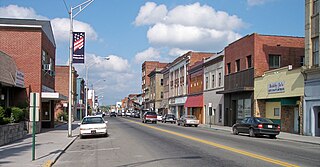The Deepwater Railway was an intrastate short line railroad located in West Virginia in the United States which operated from 1898 to 1907.
William N. Page, a civil engineer and entrepreneur, had begun a small logging railroad in Fayette County in 1896, sometimes called the Loup Creek and Deepwater Railway. It extended from an interchange at Deep Water with the Chesapeake and Ohio Railway (C&O) on the south bank of the navigable Kanawha River 4 miles (6.4 km) up a steep grade into the mountainous terrain southward, following the winding Loup Creek to reach a sawmill at Robson which was owned by the Loup Creek Estate. It was operated by the C&O under a verbal agreement.
In 1898, the Deepwater Railway was incorporated, and an extension was planned to reach nearby coal deposits at Page. In 1902, assisted by silent partner, millionaire industrialist Henry H. Rogers of Standard Oil fame, Page expanded his plans, first to extend further in West Virginia to Matoaka. [1] In 1907, the Deepwater Railway was acquired by its sister Tidewater Railway to form the Virginian Railway.

Victoria is an incorporated town in Lunenburg County, Virginia, United States. The population was 1,725 at the 2010 census, which was down from the 1,821 reported in 2000.

Princeton is a city in and the county seat of Mercer County, West Virginia, United States. The population was 5,872 at the 2020 census. It is part of the Bluefield micropolitan area. The city hosts the Princeton WhistlePigs baseball club of the Appalachian League.

Henry Huttleston Rogers was an American industrialist and financier. He made his fortune in the oil refining business, becoming a leader at Standard Oil. He also played a major role in numerous corporations and business enterprises in the gas industry, copper, and railroads. He became a close friend of Mark Twain.

The Virginian Railway was a Class I railroad located in Virginia and West Virginia in the United States. The VGN was created to transport high quality "smokeless" bituminous coal from southern West Virginia to port at Hampton Roads.

The Norfolk and Western Railway, commonly called the N&W, was a US class I railroad, formed by more than 200 railroad mergers between 1838 and 1982. It was headquartered in Roanoke, Virginia, for most of its existence. Its motto was "Precision Transportation"; it had a variety of nicknames, including "King Coal" and "British Railway of America". In 1986, N&W merged with Southern Railway to form today's Norfolk Southern Railway.

The Chesapeake and Ohio Railway was a Class I railroad formed in 1869 in Virginia from several smaller Virginia railroads begun in the 19th century. Led by industrialist Collis P. Huntington, it reached from Virginia's capital city of Richmond to the Ohio River by 1873, where the railroad town of Huntington, West Virginia, was named for him.

Sewells Point is a peninsula of land in the independent city of Norfolk, Virginia in the United States, located at the mouth of the salt-water port of Hampton Roads. Sewells Point is bordered by water on three sides, with Willoughby Bay to the north, Hampton Roads to the west, and the Lafayette River to the south. It is the site of Naval Station Norfolk.

William Nelson Page was an American civil engineer and industrialist. He was active in the Virginias following the U.S. Civil War. Page was widely known as a metallurgical expert by other industry leaders and investors as well as state and federal authorities.
The Tidewater Railway, also known as the Tidewater Railway Company, was formed in 1904 as an intrastate railroad in Virginia, in the United States, by William N. Page, a civil engineer and entrepreneur, and his silent partner, millionaire industrialist Henry Huttleston Rogers of Standard Oil fame. It was put together with the intention of creating an outlet to Hampton Roads, where coal mined along their older West Virginia short-line railroad, the Deepwater Railway, could be exported. In 1906, Thomas Davis Ranson served as vice president.

The Monongahela Railway was a coal-hauling short line railroad in Pennsylvania and West Virginia in the United States. It was jointly controlled originally by the Pennsylvania Railroad, New York Central subsidiary Pittsburgh and Lake Erie Railroad, and the Baltimore and Ohio Railroad, with NYC and PRR later succeeded by Penn Central Transportation. The company operated its own line until it was merged into Conrail on May 1, 1993.
Page is a census-designated place (CDP) and coal town in Fayette County, West Virginia, United States. As of the 2010 census, its population was 224. It was named for William Nelson Page (1854-1932), a civil engineer and industrialist who lived in nearby Ansted, where he managed Gauley Mountain Coal Company and many iron, coal, and railroad enterprises.

Deep Water, also known historically as Deepwater, is a census-designated place on the Kanawha River in Fayette County, West Virginia, United States. As of the 2010 census, its population was 280. It is best known as the starting point of the Deepwater Railway founded in 1898 by William N. Page, which was merged to create the Virginian Railway in 1907.

The James River and Kanawha Canal was a partially built canal in Virginia intended to facilitate shipments of passengers and freight by water between the western counties of Virginia and the coast. Ultimately its towpath became the roadbed for a rail line following the same course.

Abram Stevens Hewitt was an American politician, educator, ironmaking industrialist, and lawyer who was mayor of New York City for two years from 1887 to 1888. He also twice served as a U.S. Congressman from New York's 10th and chaired the Democratic National Committee from 1876 to 1877.

The Western Maryland Railway was an American Class I railroad (1852–1983) that operated in Maryland, West Virginia, and Pennsylvania. It was primarily a coal hauling and freight railroad, with a small passenger train operation.
The Winding Gulf Coalfield is located in western Raleigh County and eastern Wyoming County, in southern West Virginia. It is named after the Winding Gulf stream, a tributary of the Guyandotte River. In the early 20th century, it was promoted as the "Billion Dollar Coalfield".

Kanawha was a 471-ton steam-powered luxury yacht initially built in 1899 for millionaire industrialist and financier Henry Huttleston Rogers (1840–1909). One of the key men in the Standard Oil Trust, Rogers was one of the last of the robber barons of the Gilded Age in the United States.
The Kanawha and Pocahontas Railroad Company was incorporated in West Virginia in 1898 by either a son or the estate of Charles Pratt to reach new coal mining territory on land which was owned and/or leased by Gallego Coal & Land Company, Charles Pratt and Company, and other investors based in New York City.

The Hocking Valley Railway was a railroad in the U.S. state of Ohio, with a main line from Toledo to Athens and Pomeroy via Columbus. It also had several branches to the coal mines of the Hocking Valley near Athens. The company became part of the Chesapeake and Ohio Railway system in 1910, and the line between Toledo and Columbus continues to see trains as CSX Transportation's Columbus Subdivision. Portions of the main line south of Columbus are now operated by the Indiana and Ohio Railway and Hocking Valley Scenic Railway.
The Morgantown and Kingwood Railroad was a railroad in West Virginia in the United States. It extended from the Baltimore and Ohio Railroad (B&O) junction in Morgantown in Monongalia County via Masontown, Kingwood and Rowlesburg to the M&K junction with the B&O in Preston County, a distance of 47.9 mi (77.1 km). The M&K also operated approximately 5 mi (8.0 km) of branch lines along the route.